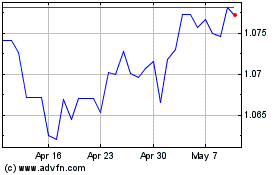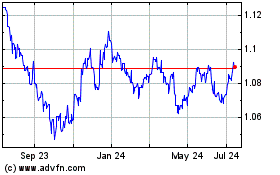Euro Lower After ECB Minutes
April 08 2021 - 6:42AM
RTTF2
The euro was weaker against its most major opponents in the
European session on Thursday, as the minutes from the European
Central Bank's March meeting showed that members broadly agreed
that a significant increase in the pace of its asset purchases was
warranted by the observed tightening of financing conditions and
the lack of a material improvement in the growth and inflation
outlook.
Policy makers expressed broad support for proposal to conduct
purchases under the PEPP over the next quarter at a significantly
higher pace than during the first few months of the year, the
minutes from the ECB's March 10-11 policy meeting showed.
Some policymakers argued that a more moderate increase in the
pace would better reflect the assessment of more balanced risks to
the outlook, also in the light of previous decisions when a similar
pace had been chosen but economic conditions had been worse.
"The Governing Council needed to avoid giving the impression of
being overly focused on sovereign yields or reacting mechanically
to a set of indicators of financing conditions," the minutes said.
There was wide agreement that the flexibility embodied in the PEPP
was symmetric, implying that the purchase pace could be increased
and decreased according to market conditions, the minutes
added.
ECB members agreed that the governing Council would undertake a
quarterly joint assessment of financing conditions and the
inflation outlook to determine the pace of purchases required to
keep financing conditions favourable.
Data from Destatis showed that Germany's factory orders growth
accelerated in February driven by domestic demand.
Factory orders grew 1.2 percent month-on-month in February,
faster than the 0.8 percent increase in January. The monthly growth
matched economists' expectations.
The euro showed a mixed trend against its major rivals in the
Asian session. While it fell against the yen, it was steady against
the pound and the franc. Versus the greenback, it climbed.
The euro fell to an 8-day low of 129.57 against the yen from
Wednesday's close of 130.37. The euro is seen finding support
around the 126.00 region.
Data from the Cabinet Office showed that Japan's consumer
confidence rose to the highest level in thirteen months in
March.
On a seasonally adjusted basis, the consumer confidence index
increased to 36.1 in March from 33.9 in February.
The euro declined to 1.1006 against the franc, its lowest level
since March 17. At Wednesday's close, the pair was valued at
1.1026. Should the euro slides further, 1.07 is likely seen as its
next support level.
The euro retreated to 0.8627 against the pound, after climbing
to 0.8657 at 4:45 am ET. The euro-pound pair had finished
yesterday's trading session at 0.8639. The euro may locate support
around the 0.84 level.
Survey data from IHS Markit showed that the UK construction
sector grew at the fastest pace since 2014 in March, underpinned by
strong rises in house building, commercial work and civil
engineering.
The Chartered Institute of Procurement & Supply construction
Purchasing Managers' Index rose to 61.7 in March from 53.3 in
February. This was the fastest expansion since September 2014.
The euro edged down to 1.6845 against the kiwi, compared to
Wednesday's close of 1.6914. The euro is likely to challenge
support around the 1.64 mark.
In contrast, the euro rebounded to 1.5580 against the aussie and
1.4996 against the loonie, from its prior lows of 1.5528 and
1.4945, respectively. Next key resistance for the euro is likely
seen around 1.57 against the aussie and 1.51 against the
loonie.
Euro vs US Dollar (FX:EURUSD)
Forex Chart
From Mar 2024 to Apr 2024

Euro vs US Dollar (FX:EURUSD)
Forex Chart
From Apr 2023 to Apr 2024
